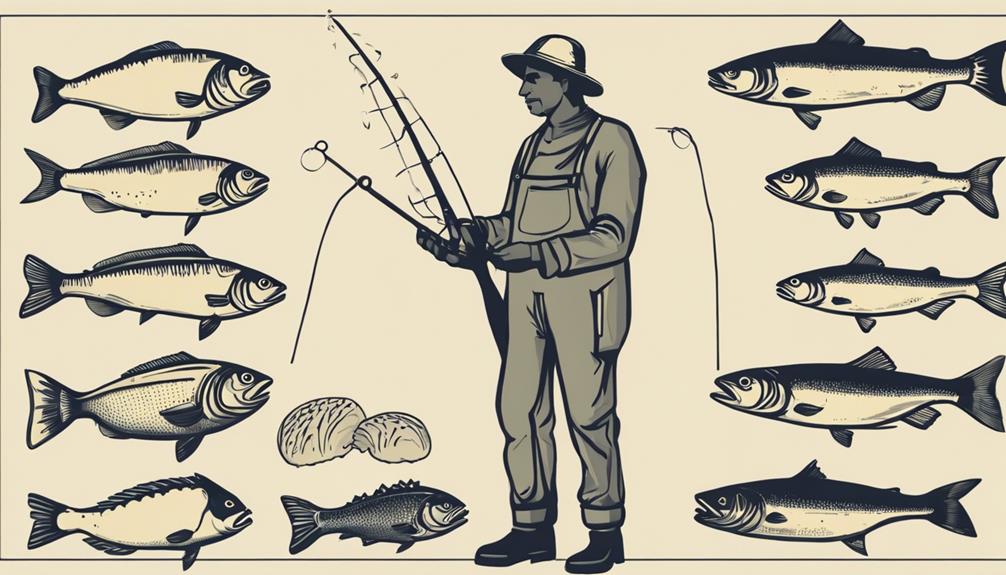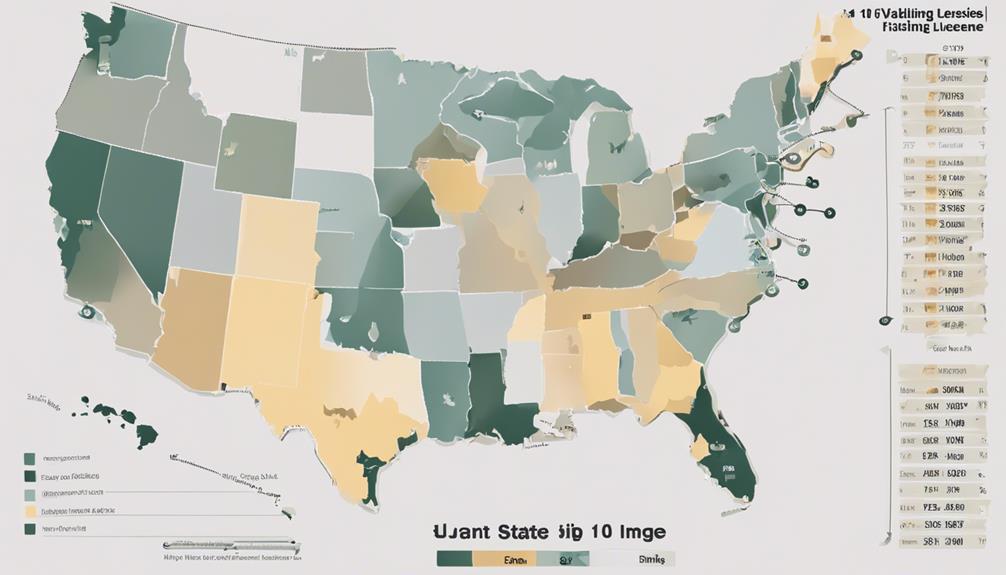When it comes to fishing regulations, navigating the waters of catch size and quantity can be like deciphering a complex map of conservation. From the types of fish subjected to strict limits to penalties for violations, understanding these 9 key regulations is crucial for both recreational and commercial anglers.
Stay informed on the intricacies of maximum catch size restrictions and enforcement measures, as well as the delicate balance between sustainable fishing practices and environmental preservation. Explore how these regulations shape the future of fishing practices and the health of our marine ecosystems.
Types of Fish Subject to Limits
When fishing, you must be aware of the specific types of fish that are subject to catch limits. Understanding fish population dynamics is crucial in ensuring sustainable fishing practices. By monitoring the population sizes of different fish species, conservation efforts can be better directed towards maintaining healthy ecosystems and preventing overfishing.
Fish population dynamics refer to the changes in fish populations over time, influenced by factors such as reproduction rates, predation, and environmental conditions. It's essential to have a good understanding of these dynamics to establish effective catch limits that protect vulnerable species and promote biodiversity.
Conservation efforts play a vital role in managing fish populations and ensuring their long-term viability. Through measures like catch limits, size restrictions, and protected areas, authorities aim to prevent depletion of fish stocks and preserve the balance of marine ecosystems. By following regulations and guidelines set by conservation organizations, anglers can contribute to the sustainability of fish populations for future generations to enjoy.
Being mindful of the types of fish subject to catch limits isn't only a legal requirement but also a moral responsibility to safeguard our marine resources. By staying informed about fish population dynamics and supporting conservation efforts, you can play a part in maintaining healthy fish populations and thriving aquatic environments.
Maximum Catch Size Restrictions
To ensure sustainable fishing practices, anglers must adhere to maximum catch size restrictions. These restrictions are based on scientific fish population studies and conservation efforts aimed at preserving marine ecosystems. By limiting the size of catches, authorities can help maintain healthy fish populations and protect endangered species from overexploitation.
Enforcing maximum catch size restrictions has a direct impact on the economic sustainability of fishing industries. By allowing fish to reach maturity and reproduce before being caught, these regulations contribute to the long-term viability of commercial fisheries. Oversized catches can disrupt the delicate balance of marine ecosystems, leading to negative consequences for both the environment and the economy.
Adhering to maximum catch size restrictions is crucial for promoting sustainable practices in fishing. It ensures that fish stocks remain stable and abundant, providing future generations with the opportunity to enjoy fishing activities. By following these regulations, anglers can contribute to the overall health of marine environments and support conservation efforts aimed at preserving biodiversity.
Daily Catch Limits per Angler
Adhering to daily catch limits per angler is essential for maintaining sustainable fishing practices and preserving marine ecosystems. These limits are put in place to prevent overfishing, allowing fish populations to replenish and ensuring the balance of the ecosystem. By adhering to these regulations, anglers contribute to the conservation benefits that come from sustainable fishing practices.
Monitoring the effectiveness of daily catch limits is crucial in ensuring their success. Authorities track catch data to assess whether the limits are being respected and if they're aiding in the recovery of fish populations. This monitoring helps in making informed decisions about potential adjustments to the limits to better support marine conservation efforts.
Angler compliance plays a significant role in the effectiveness of daily catch limits. Education initiatives are key to ensuring that anglers understand the importance of these regulations and the impact of their actions on marine ecosystems. By raising awareness about the reasons behind daily catch limits and the benefits they bring, anglers are more likely to comply and become stewards of sustainable fishing practices.
Size Regulations for Specific Species
Understanding the size regulations for specific species is crucial for responsible fishing practices and ecosystem conservation. Minimum size requirements are put in place to ensure that fish have the opportunity to reproduce before being caught. These regulations play a vital role in conservation efforts as they help in maintaining healthy fish populations and preserving the balance within the ecosystem.
By adhering to minimum size requirements, you contribute to the sustainability of fish stocks. When smaller fish are caught before they reach maturity, it can have a significant impact on the ecosystem. Removing juvenile fish disrupts the natural order, affecting the food chain and overall ecological balance. Through following size regulations, you help in allowing fish populations to thrive and fulfill their ecological roles.
Conservation efforts rely on fishermen understanding and obeying these size regulations. It isn't just about catching fish but doing so responsibly. By releasing undersized fish, you give them a chance to grow and reproduce, supporting the long-term health of the species. Ultimately, your compliance with size regulations demonstrates your commitment to preserving marine environments for future generations of anglers to enjoy.
Catch and Release Guidelines
Follow these catch and release guidelines to ensure the sustainability of fish populations and promote responsible fishing practices. When practicing catch and release, it's essential to follow ethical angling practices to minimize harm to fish populations. This includes using barbless hooks to facilitate easier hook removal, handling fish with wet hands to protect their slime layer, and avoiding bringing fish out of the water for extended periods.
Conservation efforts are crucial in maintaining healthy fish populations. By releasing fish back into their natural habitat, anglers contribute to the preservation of species and ecosystems. It's important to consider the environmental impact of fishing activities and strive to minimize any negative effects. Sustainable fishing practices, such as catch and release, play a significant role in ensuring that fish populations remain stable for future generations to enjoy.
Restrictions on Commercial Fishing
Implementing strict regulations on commercial fishing practices is essential to protect marine ecosystems and sustain fish populations. Sustainable practices and conservation efforts are crucial to ensure the long-term viability of fisheries and the health of ocean ecosystems. By setting restrictions on commercial fishing activities, such as catch limits, gear regulations, and seasonal closures, authorities aim to prevent overfishing and minimize harm to non-target species.
These regulations not only benefit the environment but also have a direct impact on the economic sustainability of the fishing industry. Overfishing can deplete fish stocks, leading to a decline in catches and potentially causing economic hardship for fishermen and related businesses. By enforcing restrictions on commercial fishing, authorities help maintain a balance that supports both the industry and the environment.
Additionally, restrictions on commercial fishing contribute to industry sustainability by promoting responsible practices that consider the long-term consequences of fishing activities. By adhering to catch limits and adopting eco-friendly gear and methods, fishermen can help ensure that fish populations remain healthy and abundant for future generations.
Enforcement of Catch Limits

To effectively enforce catch limits in commercial fishing, ensure that all vessels are equipped with tracking devices. Monitoring systems play a crucial role in overseeing fishing activities and ensuring compliance with catch limits. By having tracking devices on board, authorities can accurately monitor the amount of fish caught by each vessel, helping to prevent overfishing and maintain sustainable fish populations.
Monitoring systems provide real-time data on fishing activities, allowing officials to track the location and movements of vessels. This technology enables authorities to compare the reported catch of a vessel with the actual amount of fish on board, ensuring that fishermen adhere to the specified catch limits. As a result, compliance rates improve, and the enforcement of catch limits becomes more effective in regulating commercial fishing practices.
High compliance rates are essential for the success of catch limit regulations. By implementing monitoring systems across the fishing fleet, authorities can deter illegal fishing practices and hold accountable those who exceed the established catch limits. This proactive approach not only protects marine ecosystems but also supports the long-term sustainability of fish stocks for future generations.
Penalties for Violating Regulations
Equipping vessels with tracking devices enables authorities to swiftly impose penalties on those who violate catch limits in commercial fishing. Enforcement procedures play a vital role in ensuring compliance with fishing regulations. When violations occur, penalties are essential to deter future infractions and protect marine ecosystems. Monitoring compliance through these tracking devices allows authorities to detect unauthorized fishing activities promptly.
Penalties for exceeding catch limits can include hefty fines, vessel confiscation, license suspension, or even imprisonment in severe cases. These consequences serve as deterrent measures, discouraging individuals and companies from flouting fishing regulations. By enforcing penalties consistently, authorities uphold the integrity of catch limits and promote sustainable fishing practices.
Enforcement procedures are crucial in maintaining the effectiveness of catch size regulations. Regular inspections and audits help verify compliance and identify potential violations. When violations are substantiated, swift and appropriate penalties must be applied to uphold the rule of law. This ensures that all stakeholders in the fishing industry adhere to the established catch limits, preserving marine biodiversity and supporting long-term fish stock sustainability.
Frequently Asked Questions
How Are Fishing Catch Size and Quantity Regulations Determined and Updated?
When figuring out fishing catch size and quantity rules, various factors come into play, like stock health and sustainability. Stakeholder engagement is crucial too, with input from fishermen, scientists, and policymakers.
By considering these aspects, regulations can be determined and updated to ensure a balance between fishing activities and marine conservation.
Are There Any Exceptions or Exemptions to the Catch Size and Quantity Regulations for Certain Types of Fishing Activities or Locations?
When it comes to exceptions and exemptions, certain types of fishing activities or locations may have different rules.
For example, recreational fishing in conservation areas could have specific regulations in place.
These exceptions are put in effect to ensure the sustainability of fish populations and protect sensitive ecological areas.
It's important to be aware of any special rules that may apply to the specific fishing activities or locations you're interested in.
How Do Catch Size and Quantity Regulations Vary Between Different States or Countries?
When comparing catch size and quantity regulations internationally, you'll find varying standards. Different states or countries have their own rules, leading to regional differences.
These regulations impact the economy and play a crucial role in achieving conservation goals. Understanding these variations allows for better management of fisheries and protection of marine resources.
Be mindful of the diverse approaches to fishing regulations across borders to ensure sustainable practices and ecological balance.
Are There Any Efforts or Initiatives in Place to Monitor and Assess the Effectiveness of These Regulations in Ensuring Sustainable Fishing Practices?
Monitoring initiatives and sustainability assessments are crucial for ensuring that fishing practices remain sustainable. Efforts are being made to monitor and assess the effectiveness of regulations in this regard.
How Can Anglers and Commercial Fishermen Contribute to the Enforcement and Compliance of Catch Size and Quantity Regulations?
To ensure compliance with catch size and quantity regulations, angler education is crucial. By understanding the rules and limits, you can actively contribute to sustainable fishing practices. Additionally, cooperation with enforcement agencies is key.
Commercial partnerships can also play a significant role by promoting conservation awareness among fishermen. Working together, anglers and commercial fishermen can help enforce and comply with regulations, ultimately aiding in the preservation of marine ecosystems.
Conclusion
Overall, it's important to follow fishing regulations on catch size and quantity to ensure the sustainability of fish populations and protect the marine ecosystem. By adhering to the specified limits and guidelines, you can help maintain a healthy balance in the aquatic environment for future generations of anglers to enjoy.
Remember, respecting these regulations not only benefits the fish and their habitats, but also the overall health of our oceans. So fish responsibly and help preserve our marine resources.



